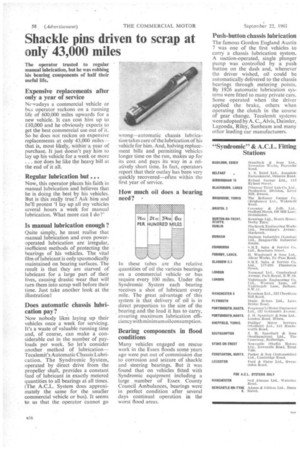Shackle pins driven to scrap at only 43,000 miles
Page 90

If you've noticed an error in this article please click here to report it so we can fix it.
The operator trusted to regular manual lubrication, but he was robbing his bearing components of half their useful life.
Expensive replacements after only a year of service
Nowadays a commercial vehicle or bus operator reckons on a running life of 600,000 miles upwards for a new vehicle. It can cost him up to £10,000 and he obviously expects to get the best commercial use out of it. So he does not reckon on expensive replacements at only 43,000 miles— that is, most likely, within-a year of purchase. It just doesn't pay him to lay up his vehicle for a week or more . . . nor does he like the heavy bill at the end of it all.
Regular lubrication but
Now, this operator places his faith in manual lubrication and believes that he is doing the best by his vehicles. But is this really true? Ask him and he'll protest 'I lay up all my vehicles several hours a week for manual lubrication. What more can I do?'
Is manual lubrication enough ?
Quite simply, he must realise that manual lubrication and even poweroperated lubrication are irregular, inefficient methods of protecting the bearings of his vehicles. The vital film of lubricant is only spasmodically maintained on bearing surfaces. The result is that they are starved of lubricant for a large • part of their lives, causing drastic wear that will turn them into scrap well before their time. Just take another look at the illustration!
Does automatic chassis lubrication pay?
Now nobody likes laying up their vehicles once a week for servicing. It's a waste of valuable running time and, of course, can make a considerable cut in the number of payloads per week. So lets consider another method of lubricationTecalemit's Automatic Chassis Lubrication. The Syndromic System, operated by direct drive from the propeller shaft, provides a constant feed of lubricant in exactly metered quantities to all bearings at all times. (The A.C.L. System does approximately the same for the smaller commercial vehicle or bus). It seems to us that the operator cannot go wrong—automatic chassis lubrication takes care of the lubrication of his vehicle for him. And, halving replacement bills and permitting vehicles longer time on the run, makes up for its cost and pays its way in a relatively short time. In fact, operators report that their outlay has been very quickly recovered—often within the first year of service.
How much oil does a bearing need? •
In these tubes are the relative quantities of oil the various bearings on a commercial vehicle or bus require every 100 miles. Under the Syndromic System each bearing receives a shot of lubricant every mile. The great advantage of this system is that delivery of oil is in direct proportion to the size of the bearing and the load it has to carry, ensuring maximum lubrication efficiency withrninim urn oil consumption.
Bearing components in flood conditions
Many vehicles engaged on rescue work in the Essex floods some years ago were put out of commission due to corrosion and seizure of shackle and steering bearings. But it was found that on vehicles fitted with Syndromic equipment including a large , number of Essex County Council Ambulances, bearings were in perfect condition after several days continual operation in the worst flood areas.
Push-button chassis lubrication
The famous Gordon England Austin 7 was one of the first vehicles to carry a chassis lubrication system. A suction-operated, single plunger pump was controlled by a push button on the dash and, whenever the driver wished, oil could be automatically delivered to the chassis bearings through metering points. By 1926 automatic lubrication systems were fitted to many private cars. Some operated when the driver applied the brake, others when operating the clutch in the course of gear change. Tecalernit systems were adopted by A. C., Alvis, Daimler, Lagonda, Riley, Sunbeam and many other leading car manufacturers.




































































































































